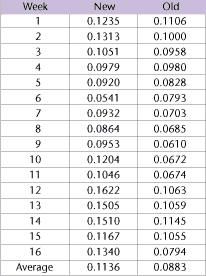All of the leaders, that is, except Lorraine. She'd received green belt training
from her previous employer, and she'd seen enough black belt presentations to know that the analysis of the sales team was seriously flawed. It was
undeniable that the project team's sales close rate was 2.53 percent higher than the sales close rate for the rest of the sales department during the 16 weeks of
the test, and, yes, the 2.53 percent did represent a 29-percent improvement over the 8.83-percent rate for the rest of the team. Despite these "facts" and
the air of objectivity surrounding the analysis, Lorraine had many unanswered questions. She asked management to delay any decision until she could explore
these questions with a Six Sigma consultant. That's where things stood when I entered the picture.
|
Table 1: Old vs.
New Closing Rates |
 |
|
|
Lorraine viewed the analysis as important because it would demonstrate that the Six Sigma approach could be applied in this service company, something that skeptical
managers didn't believe. In a meeting with the sales team leader, I was presented with the data shown in Table 1. As often happens, this summary data was all that
was available; for a variety of reasons (but chiefly due to a time constraint) the number of sales calls used to compute these rates could not be obtained.
If you are a black belt or master black belt, or just statistically inclined, please take a couple of minutes before reading the remainder of this column to think about the
data and jot down how you'd proceed from here.
When dealing with the data in Table 1, it's tempting to apply a statistical
technique such as a paired t-test to it. Using Microsoft Excel, it's a simple matter to compute the t-statistic, which is 4.55, a highly significant result.
Statistical purists would ask if the data are approximately normal and an endless variety of other technical questions about the data. I would argue,
however, that all of this is premature and, ultimately, beside the point. The first order of business is to determine if we are comparing apples to apples.
Table 2: Apples-to-Apples Comparison
Further discussion revealed that the company had not two but nine sales teams,
all of the same size. A further complication was that the teams sold different products. More probing uncovered the fact that four of the eight other teams
sold a product mix similar to that of the team using the new closing method. At this point it appeared that, to make an apples-to-apples comparison, you
would assess the results of these five teams for the 16-week project. Descriptive statistics are shown in Table 2.
Table 3: Data Groups |
 |
|
 |
|
|
Further analysis using nonparametric methods indicated that there are three distinct groups in these data (see Table 3). Table 3 presents a decidedly different
picture than was originally given to management. The new closing method now appears to be no better than normal. Still, there are bright spots. Assuming that
teams 5 and 8 aren't oranges being compared to apples, potential gains should be possible from discovering why team 5 performs under the norm, and why
team 8 outperforms the norm. More information might also be obtained by plotting the 16 weeks over time to identify trends and other patterns. Using the
Six Sigma approach, the information can be converted to knowledge, the knowledge to action, and the action to an improved bottom line. It's more
work than the old standby, the bar chart, but it's worth it.
The complete data file used in this column is posted at
www.pyzdek.com/2000-05.xls . The challenge is to analyze the data in a number of different ways to determine how the different analyses would affect
management decisions. Send your results to me for inclusion in a future column.
About the author
Thomas Pyzdek is president of Pyzdek Consulting Inc. and a consultant in Six Sigma. He has written more than 50 copyrighted works, including
The Complete Guide to Six Sigma. To learn more about Six Sigma, visit www.pyzdek.com . E-mail Pyzdek at
Tom Pyzdek .